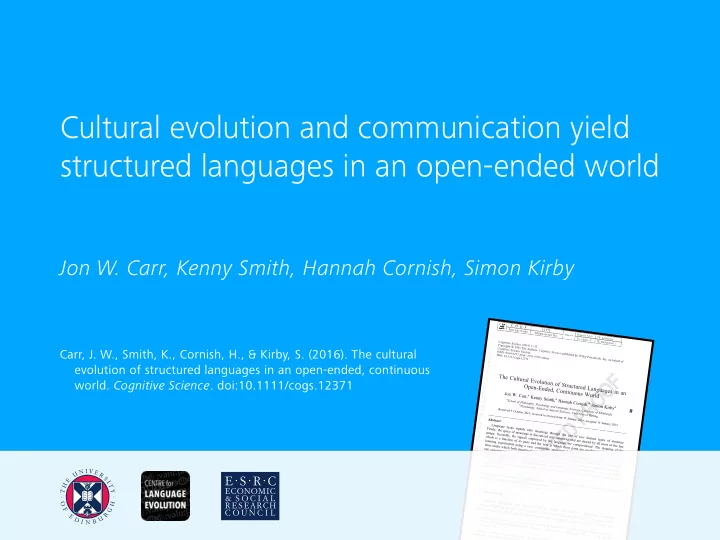

Cultural evolution and communication yield structured languages in an open-ended world Jon W. Carr, Kenny Smith, Hannah Cornish, Simon Kirby Carr, J. W., Smith, K., Cornish, H., & Kirby, S. (2016). The cultural evolution of structured languages in an open-ended, continuous world. Cognitive Science . doi:10.1111/cogs.12371
What shapes language? Language
What shapes language? Language Expressivity
What shapes language? Language Expressivity Learnability Kirby, Tamariz, Cornish, & Smith, 2015, Cognition
What shapes language? Language Informativeness Simplicity Kirby, Tamariz, Cornish, & Smith, 2015, Cognition Kemp & Regier, 2012, Science
What shapes language? Language Deutlichkeitsstreben Bequemlichkeitsstreben Kirby, Tamariz, Cornish, & Smith, 2015, Cognition Kemp & Regier, 2012, Science
Iterated learning Emergence of compositional Emergence of categorical structure structure in the signals in the meanings Kirby, Cornish, & Smith, 2008, PNAS Xu, Dowman, & Griffiths, 2013, Proc R Soc B
Can we see the emergence of compositional structure under a continuous, open- ended meaning space?
Experiments Experiment 1 Pressure to be learnable from cultural transmission No pressure to be expressive Result: Categories emerge in the meaning space Experiment 2 Pressure to be learnable from cultural transmission Pressure to be expressive from communication Result: “Compositional” structure emerges in the signals
Experiment 1
Stimuli
Vast in magnitude 6 × 10 15 possible triangle stimuli Complex dimensions Many possible dimensions to the space Continuous On each dimension, the triangle stimuli vary over a continuous scale
Experimental design Training Test Training Test Training Test output etc… input output input output input DYNAMIC SET 1 DYNAMIC SET 2 DYNAMIC SET 0 etc… STATIC SET STATIC SET Generation 1 Generation 2 Generation 3
Training phase × 144
Test phase × 96
2 Generation number 4 5 6 7 8 9 10 0.0 0 0.2 0.4 0.6 0.8 1.0 Transmission error Chain A Chain B 3 1 Chain D 9 1 2 3 4 5 6 7 8 10 0 Generation number 0 10 20 30 40 50 Number of unique strings Chain C Expressivity Learnability
fama
fama
a m a p fama
a m a p fama fod
a m a p muaki fama fod
a m a p muaki kazizui fama fod kazizizui k a z i z i z u
Generation Generation Generation Generation Generation Generation Generation Generation Generation Generation Generation 10 1 2 5 3 4 6 7 8 9 0
Generation Generation Generation Generation Generation Generation Generation Generation Generation Generation 10 7 6 5 8 4 3 9 2 1
Generation Generation Generation Generation Generation Generation Generation Generation Generation 10 3 4 6 5 7 8 9 2
Generation Generation Generation Generation Generation Generation Generation Generation 10 9 8 7 6 5 4 3
Generation Generation Generation Generation Generation Generation Generation 10 9 8 7 6 5 4
Generation Generation Generation Generation Generation Generation 10 9 8 7 6 5
Generation Generation Generation Generation Generation 10 9 8 7 6
Generation Generation Generation Generation 10 9 8 7
Generation Generation Generation 10 9 8
Generation Generation 10 9
Generation 10 mamo pika
Experiment 2
Experimental design Training Communicative Training Communicative Training Communicative input output input output input output etc… DYNAMIC SET 0 DYNAMIC SET 1 DYNAMIC SET 2 STATIC SET etc… STATIC SET Generation 1 Generation 2 Generation 3
! " × 96
2 Generation number 4 5 6 7 8 9 10 0.0 0 0.2 0.4 0.6 0.8 1.0 Transmission error Chain I Chain J 3 1 Chain L 9 1 2 3 4 5 6 7 8 10 0 Generation number 0 10 20 30 40 50 Number of unique strings Chain K Expressivity Learnability
0 6 0 Sublexical structure 14 12 10 8 4 2 2 0 −2 Generation number 10 9 8 1 3 1 Chain C Chain L Chain J Chain K Chain I Chain D Chain B Chain A 4 Generation number 10 9 8 7 6 5 7 6 5 10 8 6 4 2 0 −2 9 4 8 7 6 5 4 3 2 10 12 14 Structure 3 2 1 0 10 9 8 7 6 5 4 3 2 1 0 Structure in the languages Experiment 1 Experiment 2
Conclusions The experimental design avoids several of the simplifications of previous experiments: • Continuous • Unstructured by the experimenter • Vast in magnitude • Different stimuli across generations Experiment 1 showed that cultural evolution can deliver languages that categorize the meaning space under pressure from learnability. Experiment 2 combined a pressure for learnability with a pressure for expressivity derived from a genuine communicative task. This gave rise to languages that use both categorization and string-internal structure to be both learnable and expressive. However, unlike previous work, this emergent structure was sublexical rather than morphosyntactic, and as such bears similarities to certain aspects of natural lexicons.
Recommend
More recommend